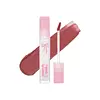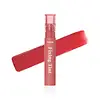What's inside
What's inside
 Key Ingredients
Key Ingredients

No key ingredients
 Benefits
Benefits

 Concerns
Concerns

 Ingredients Side-by-side
Ingredients Side-by-side

Dimethicone
EmollientDimethicone Crosspolymer
Emulsion StabilisingDiisostearyl Malate
EmollientDimethicone/Vinyl Dimethicone Crosspolymer
Skin ConditioningIsododecane
EmollientCI 77891
Cosmetic ColorantAluminum Hydroxide
EmollientPEG-10 Dimethicone
Skin Conditioning1,2-Hexanediol
Skin ConditioningCI 77492
Cosmetic ColorantCI 15850
Cosmetic ColorantDisteardimonium Hectorite
StabilisingParfum
MaskingSorbitan Sesquioleate
EmulsifyingPropylene Carbonate
SolventCI 42090
Cosmetic ColorantWater
Skin ConditioningIsododecane
EmollientDimethicone
EmollientVinyl Dimethicone/Methicone Silsesquioxane Crosspolymer
Butylene Glycol
HumectantDisteardimonium Hectorite
StabilisingTricalcium Phosphate
AbrasiveDimethicone/Vinyl Dimethicone Crosspolymer
Skin ConditioningSorbitan Isostearate
EmulsifyingLauryl Polyglyceryl-3 Polydimethylsiloxyethyl Dimethicone
Skin ConditioningDiisostearyl Malate
EmollientDiglycerin
HumectantCetyl PEG/PPG-10/1 Dimethicone
EmulsifyingStearyl Dimethicone
EmollientMagnesium Sulfate
Diphenylsiloxy Phenyl Trimethicone
Skin ConditioningPropylene Carbonate
SolventCI 77891
Cosmetic ColorantCI 15850
Cosmetic ColorantPolyglyceryl-3 Diisostearate
EmulsifyingOctadecene
SolventAcrylates/Polytrimethylsiloxymethacrylate Copolymer
Skin ConditioningCI 19140
Cosmetic ColorantPolyglyceryl-3 Polydimethylsiloxyethyl Dimethicone
Skin ConditioningParfum
MaskingSorbitan Olivate
EmulsifyingSilica Dimethyl Silylate
EmollientCI 77491
Cosmetic ColorantCI 15985
Cosmetic ColorantTriethoxycaprylylsilane
CI 45410
Cosmetic ColorantSorbitan Sesquioleate
EmulsifyingEthylhexylglycerin
Skin ConditioningCI 42090
Cosmetic ColorantTocopherol
AntioxidantPentaerythrityl Tetra-Di-T-Butyl Hydroxyhydrocinnamate
AntioxidantWater, Isododecane, Dimethicone, Vinyl Dimethicone/Methicone Silsesquioxane Crosspolymer, Butylene Glycol, Disteardimonium Hectorite, Tricalcium Phosphate, Dimethicone/Vinyl Dimethicone Crosspolymer, Sorbitan Isostearate, Lauryl Polyglyceryl-3 Polydimethylsiloxyethyl Dimethicone, Diisostearyl Malate, Diglycerin, Cetyl PEG/PPG-10/1 Dimethicone, Stearyl Dimethicone, Magnesium Sulfate, Diphenylsiloxy Phenyl Trimethicone, Propylene Carbonate, CI 77891, CI 15850, Polyglyceryl-3 Diisostearate, Octadecene, Acrylates/Polytrimethylsiloxymethacrylate Copolymer, CI 19140, Polyglyceryl-3 Polydimethylsiloxyethyl Dimethicone, Parfum, Sorbitan Olivate, Silica Dimethyl Silylate, CI 77491, CI 15985, Triethoxycaprylylsilane, CI 45410, Sorbitan Sesquioleate, Ethylhexylglycerin, CI 42090, Tocopherol, Pentaerythrityl Tetra-Di-T-Butyl Hydroxyhydrocinnamate
 Reviews
Reviews

Ingredients Explained
These ingredients are found in both products.
Ingredients higher up in an ingredient list are typically present in a larger amount.
Ci 15850 is the pigment color red. It is an azo dye and created synthetically.
Azo dyes need to be thoroughly purified before use. This allows them to be more stable and longer-lasting.
This ingredient is common in foundations, lipsticks, and blushes. This color is described as brown/orangey red.
It has many secondary names such as Red 6 and Red 7. According to a manufacturer, Red 6 usually contains aluminum.
Learn more about CI 15850Ci 42090 is a synthetic dye created from petroleum. It is used to give a bright blue color to cosmetics, medicine, and food.
Ci 77891 is a white pigment from Titanium dioxide. It is naturally found in minerals such as rutile and ilmenite.
It's main function is to add a white color to cosmetics. It can also be mixed with other colors to create different shades.
Ci 77891 is commonly found in sunscreens due to its ability to block UV rays.
Learn more about CI 77891Diisostearyl Malate is an emollient and most often used in lip products. It comes from isostearyl alcohol, a fatty acid, and malic acid, an AHA.
As an emollient, Diisostearyl Malate helps create a thin film on your skin to trap moisture in. This helps keep your skin soft and smooth.
Dimethicone is a type of synthetic silicone created from natural materials such as quartz.
What it does:
Dimethicone comes in different viscosities:
Depending on the viscosity, dimethicone has different properties.
Ingredients lists don't always show which type is used, so we recommend reaching out to the brand if you have questions about the viscosity.
This ingredient is unlikely to cause irritation because it does not get absorbed into skin. However, people with silicone allergies should be careful about using this ingredient.
Note: Dimethicone may contribute to pilling. This is because it is not oil or water soluble, so pilling may occur when layered with products. When mixed with heavy oils in a formula, the outcome is also quite greasy.
Learn more about DimethiconeThis ingredient is a silicone used to improve the texture of products and absorb oil. It does not get absorbed into the skin.
Like other silicones, Dimethicone/Vinyl Dimethicone Crosspolymer helps condition the skin by creating a barrier. In this sense, it can act as an emollient and trap moisture in.
This ingredient is a type of elastomer.
Learn more about Dimethicone/Vinyl Dimethicone CrosspolymerDisteardimonium Hectorite comes from the clay mineral named hectorite. It is used to add thickness to a product.
It can also help stabilize a product by helping to disperse other ingredients.
Hectorite is a rare, white clay mineral.
Learn more about Disteardimonium HectoriteIsododecane is a fragrance, emollient, and solvent.
As an emollient, it helps your skin stay soft and hydrated. Emollients help trap moisture into your skin.
Isododecane's role as a solvent makes it a great texture enhancer. It spreads smoothly on skin and does not leave a sticky feeling behind. Isododecane also helps prevent color transfer in makeup products.
Isododecane is not absorbed into skin.
Learn more about IsododecaneParfum is a catch-all term for an ingredient or more that is used to give a scent to products.
Also called "fragrance", this ingredient can be a blend of hundreds of chemicals or plant oils. This means every product with "fragrance" or "parfum" in the ingredients list is a different mixture.
For instance, Habanolide is a proprietary trade name for a specific aroma chemical. When used as a fragrance ingredient in cosmetics, most aroma chemicals fall under the broad labeling category of “FRAGRANCE” or “PARFUM” according to EU and US regulations.
The term 'parfum' or 'fragrance' is not regulated in many countries. In many cases, it is up to the brand to define this term.
For instance, many brands choose to label themselves as "fragrance-free" because they are not using synthetic fragrances. However, their products may still contain ingredients such as essential oils that are considered a fragrance by INCI standards.
One example is Calendula flower extract. Calendula is an essential oil that still imparts a scent or 'fragrance'.
Depending on the blend, the ingredients in the mixture can cause allergies and sensitivities on the skin. Some ingredients that are known EU allergens include linalool and citronellol.
Parfum can also be used to mask or cover an unpleasant scent.
The bottom line is: not all fragrances/parfum/ingredients are created equally. If you are worried about fragrances, we recommend taking a closer look at an ingredient. And of course, we always recommend speaking with a professional.
Learn more about ParfumThis ingredient is a solvent. It helps dissolve active ingredients and alter the texture of products.
Propylene Carbonate is commonly used in makeup and with clay, such as montmorillonite or bentonite.
Studies show this ingredient to be safe for cosmetics. When it is undiluted, it can cause skin irritation. (It is always diluted in skincare and makeup). This ingredient is water-soluble.
Propylene Carbonate is created from propylene glycol and carbonic acid.
Learn more about Propylene CarbonateSorbitan Sesquioleate is derived from sorbitol and oleic acid. It is an emulsifier and prevents ingredients from separating.
Specifically, this ingredient is a water-in-oil emulsifier, meaning it helps water dissolve into oil.
Some studies suggest this ingredient may cause irritation in some people. If you are unsure, it is best to patch test.
This ingredient may not be Malassezia folliculitis, or fungal-acne safe.
Learn more about Sorbitan Sesquioleate